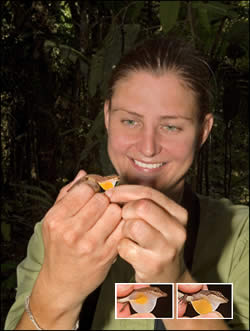Female lizards may determine male coloration
Rhett A. Butler, mongabay.com
December 27, 2005
Male lizard color may result from female preference.
The anole lizard’s dewlap — a flap of skin that hangs beneath its chin — plays an important role in species recognition, territorial defense and courtship. According to the Smithsonian Tropical Research Institute (STRI), a leading research institution in Panama, male slender anoles (Norops limifrons) exhibit variation in dewlap color ranging from orange dewlaps in Gamboa populations, white with an orange spot on Barro Colorado Island, and mixed populations in Soberania.
Researchers at STRI hypothesize that differences in dewlap coloration between populations is that some aspect of sexual selection, such as female choice or male competition may contribute to maintain them.
To test this hypothesis, STRI postdoctoral fellow Jessica Stapley from Australia, conducts experiments to determine if dewlap colors change during the life of the lizard, if females care about color or if these influence male contest success.
 STRI postdoctoral fellow Jessica Stapley |
Her preliminary findings suggest that dewlap colors are fixed from an early age and that female preference is influenced by her experience, preferring males of the same dewlap color as the familiar male overlapping her territory, thus helping to maintain one dewlap color in a population. “If a white male moves into an orange population, he is unlikely to attract females, and may suffer a reduced reproductive success” concludes Stapley.
In this case, different is not better. Standing out or “peacocking” with different colors than neighbors appears not to be a successful sexual strategy for male lizards.
— The Smithsonian Tropical Research Institute
This brief is based on a news release from the Smithsonian Tropical Research Institute.